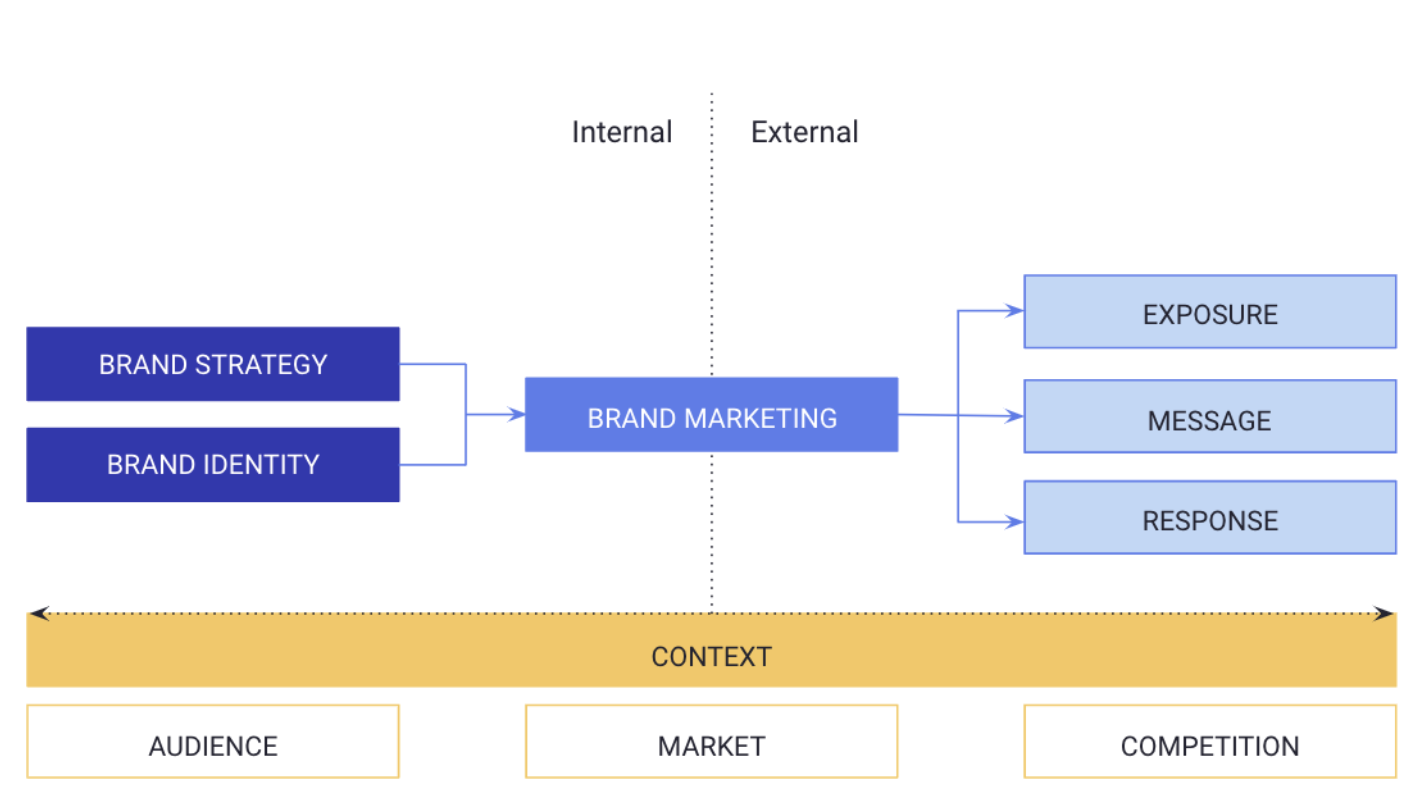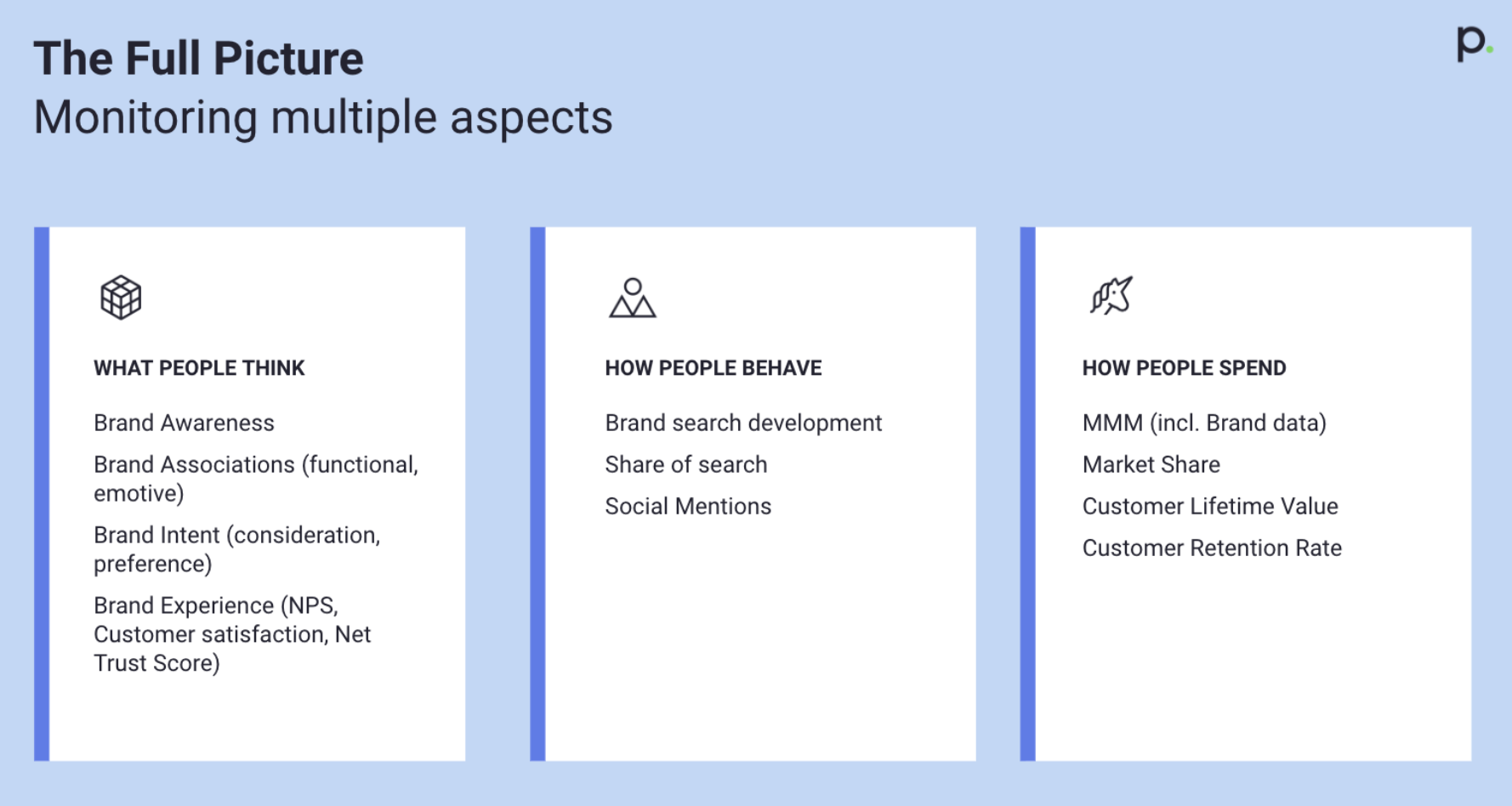5 brand marketing myths every marketer needs to stop believing

Karolina Lapinaite
Head of Media
As a marketer, you probably recognise the temptation of chasing immediate performance marketing results. But, in our pursuit of short-term gains, could you be neglecting the advantages that brand marketing offers in the long run? The answer is yes.
Many of us have preconceived ideas about brand marketing that prevent us from fully understanding its potential. In this article, we’re debunking the 5 most pervasive myths about brand marketing:
- Brand marketing and performance marketing are separate strategies
- Brand marketing = upper-funnel activities
- Reach and awareness are the only goals of brand marketing
- Brand marketing is fluffy and unmeasurable
- Brand marketing requires large advertising budgets
With today’s economic uncertainties, it’s easy to misunderstand the true value of brand marketing, but this misconception does a disservice to your overall strategy.
Whether you’re here to challenge your own perceptions or to understand how to prove its value to your CFO, let’s rethink these common misconceptions.
Hold that thought. First, let’s agree on some basics.
The right vocab
For the sake of this article (and everyone’s sanity), let’s get some vocabulary straight.
Branding
Often used interchangeably with brand marketing, but it fundamentally is about building the brand’s identity – its logo, messaging, tone of voice, and overall visual and verbal representation. It’s about making the brand memorable and consistent.
Brand strategy
This is the game plan for the brand’s direction. It involves defining what position the brand should hold in the market, what associations to cultivate, and the vision the business commits to.
Brand marketing
This is where storytelling and exposure come into play. It includes all efforts to communicate the brand’s message through advertising, content marketing, client experience, and any other paid, owned, or in-person medium.
Brand building
Brand building encompasses all activities that contribute to developing and strengthening the brand over time, ensuring it grows in value and recognition. It’s about contributing to building brand equity, which generally covers five areas: awareness, associations, perceived quality, loyalty, and proprietary assets (Aaker model, 1991).
The strategic context of brand marketing
Alright, so far, so good. But to understand how to create actual impact with brand marketing, we need to understand its context first, so let’s look at the foundational elements of all things “brand”:
The core of effective brand marketing lies in a well-defined brand strategy and identity. Without these, brand marketing efforts lack direction and cohesion.
- The brand strategy outlines where the business positions itself in the market, its mission, and its unique value propositions.
- The brand identity encompasses the visual and verbal elements that make the brand recognisable and memorable.
Brand marketing translates these foundational elements into exposure, message, and response. It involves strategically placing the brand in various media (paid, organic, earned) to maximise visibility, crafting consistent and compelling messages that resonate with the audience, and continuously evaluating feedback to refine and optimise efforts.
All these elements are influenced by the broader context, including audience behaviour, market dynamics, and competitive activities.
Now that we have this out of the way, let’s start with the first and the most common assumption. It feels like challenging 30 years of digital marketing history and thousands of marketers, but… why not?
Myth #1: Brand marketing and performance marketing are separate strategies
By separating the two over time, we have conditioned ourselves to think that brand marketing doesn’t drive performance. In reality, all marketing needs to perform by finding the balance between generating new demand and capturing existing demand.
Effective brand marketing builds long-term value by shaping people’s perceptions, which in turn strengthens performance marketing by establishing a foundation of trust and recognition. It also influences if and how people think of the brand when a certain need or desire arises.
- For example: I’m moving and want a stylish sofa → I think of X brand because, over time, I was primed through the brand’s communication that they represent stylish furniture.
Alternatively, insights from performance data can help refine brand strategies, creating a feedback loop that drives sustainable growth.
Myth #2: Brand marketing = upper-funnel activities
The main struggle with the funnel is that it suggests a linear customer journey, which in today’s marketing complexity is far from reality. It’s a convenient method to structure certain activities but can also easily serve as a blocker for the bigger picture – especially for B2B companies.
No single touchpoint drives awareness, consideration, or sales alone. It’s important to think about this not only from a targeting or action perspective but also from a perception-shaping standpoint. For instance, the consideration stage isn’t just about driving traffic – it might involve working on specific associations that people have about the brand to encourage consideration.
Brand marketing is focused on building a cohesive and compelling experience at every touchpoint, driving not just awareness but deeper engagement and preference as well. It’s the cumulative effect of all interactions that shape consumer behaviour.
Myth #3: Reach and awareness are the only goals of brand marketing
Again, many believe that brand marketing is solely about reaching audiences and raising awareness. While these are important aspects, brand marketing’s goals extend much further.
Effective brand marketing ensures that consumers associate the brand with attributes that influence their choices, such as quality, social responsibility, innovation, or other key traits defined in the brand strategy. These associations build perceptions that evolve into memory structures, making the brand top-of-mind when a need arises.
Moreover, brand marketing aims to increase consideration and preference, not just awareness. It’s about creating positive associations, shaping consumer perceptions, and building brand loyalty. For instance, there could be high awareness but low consideration or preference, indicating a need to strengthen those aspects.
In short, brand marketing’s goals include enhancing engagement, increasing brand equity, and encouraging long-term loyalty, demonstrating its value beyond mere reach and awareness.
Myth #4: Brand marketing is fluffy and unmeasurable
It’s not that brand marketing is unmeasurable; it’s that it requires a different type of thinking and approach to evaluation. Comprehensive evaluation involves monitoring multiple aspects over time to understand shifts in behaviour and perception.
By combining various methods and metrics, brands can gain a multi-dimensional view of their marketing effectiveness. There are different tiers of evaluating and optimising for brand performance, from operational tactics to sophisticated models.
And as an agency very nerdy about all things data and attribution, we have all the right resources for you! Here are some common practices to consider:
- Optimising ads for active attention not only helps reduce ad waste but has proven to lead to better advertising results in both brand and sales metrics.
- Run relevant tests. Geo-lifts can measure the impact of local campaigns by comparing sales in targeted areas against control areas. Causal impacts can test specific interventions by analysing changes in behaviour or perceptions directly linked to marketing efforts. It’s about choosing what’s relevant and can answer the question at hand.
- Observe brand search development/share of search. This method helps monitor brand interest over time, providing insights into how marketing activities influence consumer curiosity and engagement. The share of search is known to correlate with the market share, so it’s a good practice to have in place.
- Implement survey-based studies. Brand lift studies help understand channel effectiveness by evaluating shifts in ad recall, awareness, consideration, or preference, whereas brand tracking surveys provide an overall understanding of the brand’s position against competitors in the market and people’s perception of it.
- Incorporate brand data into Marketing Mix Modeling (MMM). This method, even if it requires more effort, data, and budgets to set up, can help reveal the impact of brand marketing efforts on sales and other business outcomes.
Brand effects can be evaluated as long as we understand that it’s about working with multiple dimensions of measurement over different time spans to gain a complete picture of brand health and its impact on business outcomes.
Myth #5: Brand marketing requires large advertising budgets.
Brand marketing often gets perceived as requiring large advertising budgets to be effective. While big budgets definitely help, this isn’t the only way to create value.
Effective brand marketing thrives on creativity and strategic resource allocation. Developing a compelling brand story and maintaining consistency across all channels can be done cost-effectively through content marketing, social media, and PR, which help amplify the brand message and build perception.
Additionally, using owned media like a website, blog, and email list allows for direct, low-cost communication with the audience, providing a platform to reinforce the brand’s narrative and strengthen engagement.
Given that 78% of shoppers feel more confident in a purchase when they view user-generated content (UGC), encouraging UGC is another budget-friendly tactic that enhances authenticity and provides organic reach and engagement. Smart programmatic tactics can also stretch smaller budgets further.
These are just some examples of how brands can effectively build and maintain a presence without breaking the bank.
Time to wrap up those myths… and move on.
Down the line, brands that stand out master the interplay between strategic insight, tactical actions, and creative execution across the dynamic customer journey.
So what are the key steps toward this?
- Start by integrating brand and performance marketing to create a pillar strategy from which all tactical decisions span out.
- Use brand consistency across all touchpoints, ensuring that every interaction serves both brand visibility and sales potential, as well as continuously raising interest.
- Set an aligned and clear KPI framework and adopt relevant evaluation methods that provide a comprehensive understanding of both sales and overall brand health development.
- Recognise that even small steps toward this integrated approach can help build a stronger presence in consumers’ minds and increase resilience to market fluctuations.
Too much of a hassle? We get it – so reach out!




